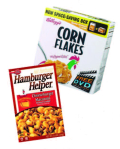
Compact packages mean more SKUs on shelves. That, in turn, means fewer stock outs and less time spent restocking.

Compact packages mean more SKUs on shelves. That, in turn, means fewer stock outs and less time spent restocking.
But the space is not coming from footage pried loose from other categories, traditionally the case. It’s coming from smaller packaging. And the original impetus is not to open up retail space, but to protect the environment. However, it is quite clear that the beneficiaries in this development are retailers, as well as the environment.
Kellogg is reducing the size of the packaging for five of its cereal brands by 8%. The new package is shorter and deeper than current packaging and will allow improved stacking. The amount of air has been decreased in the interior bag, so the same amount of cereal now fits into a smaller paperboard package. While General Mills has not yet announced a similar initiative, if the cereal aisle goes the way of the detergent aisle, they may do so. Currently, the downsized Kellogg packages are in test in stores the Detroit market, including Walmart and Kroger.
The Kellogg test box, at least the 12-ounce size for Corn Flakes, appears about 25% shorter, but roughly 10% to 15% wider and perhaps a third deeper. In the detergent aisle, the introduction of concentrated product allowed a reduction in packaging of 22% to 43%, according to Procter & Gamble. The cereal box reduction is not quite to so dramatic, but will still provide plenty of shelf space benefits for retailers.
Indeed, retail detergent category managers are pleased with the downsizing that took place in their category. More selling units were put on the shelf, due to less width and depth. Resets took advantage of this and provided more selling power to the category. Variety was increased. “It was a plus,” notes one category manager, “we now have more potential sales on the shelf.”
And, according to IRI data, liquid laundry detergents have been doing just fine since the large-scale introduction of concentrated, small-package product in 2007. Liquid laundry detergent sales were up more than 5%, year over year, in the 13 weeks ended Dec. 28, 2008, which followed a 6% gain in the previous quarter. In contrast, the remainder of the laundry products department has almost entirely shown year-over-year declines.
Cereal buyers have similar reactions. Says one: “We need to find out if the smaller packages appeal to consumers as products they want to buy, for the environment and pantry storage. If it does appeal, then we can look at the retail benefits.” Those benefits can mean more stock-keeping units (SKUs) on the shelf and better utilization of space. In addition, the reduced height will enable shelf sets to present more product to consumers.
Another plus is the reduction of warehousing costs and the greater productivity gained from being able to put more cases on a pallet.
Will the smaller-package trend stop in the cereal aisle? Likely not and here’s an example. General Mills, by reducing the variety of spices, toppings and pasta for Hamburger Helper, reduced package size by 20% for the same amount of product, thus increasing shelf pack out by 20%. Smaller packages and better space utilization are going to be the new look of grocery store shelves.
